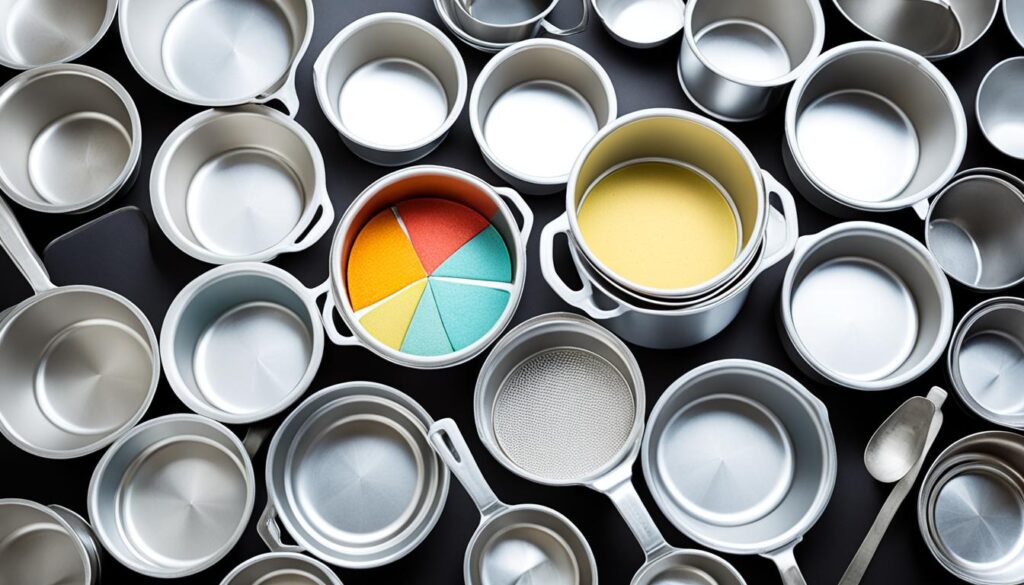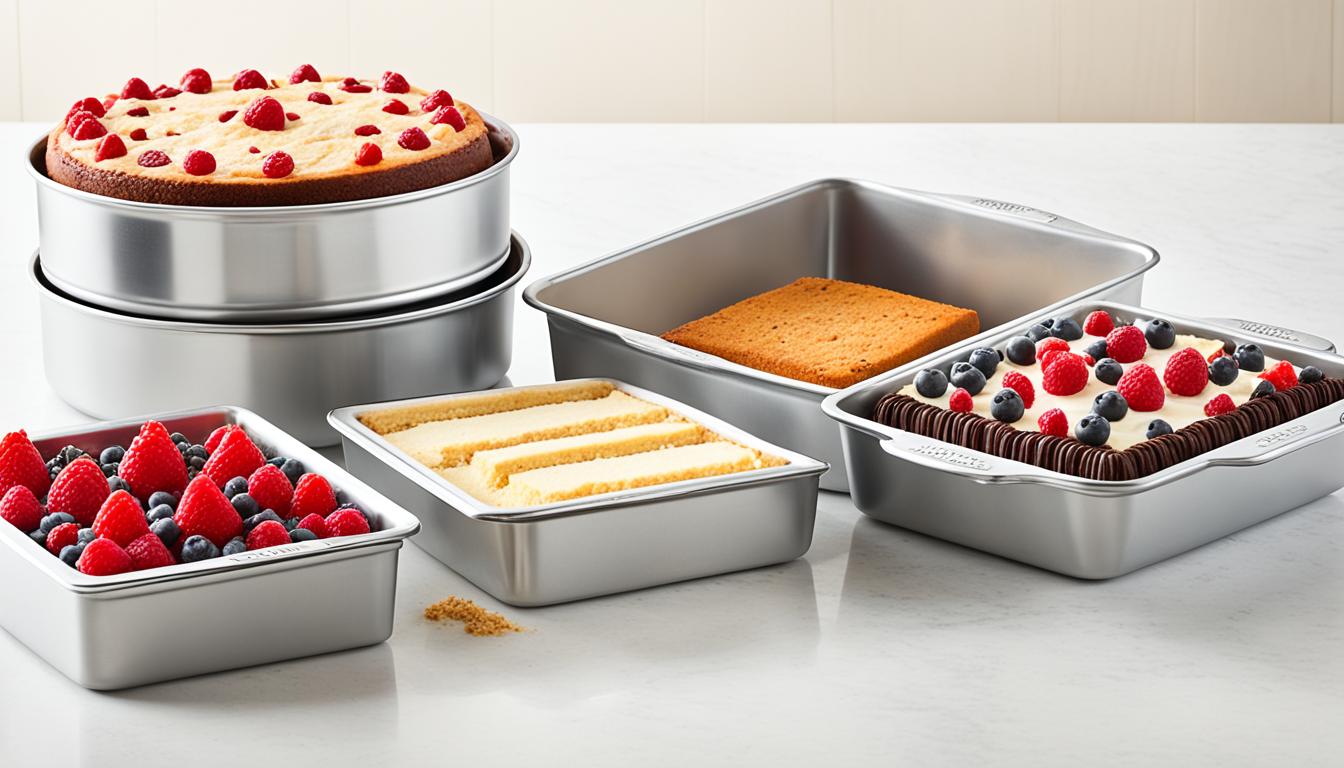Did you know that Americans consume over 2 billion pounds of cake each year, with the average person enjoying nearly 4 pounds annually? The best thing about cake is that it comes in many forms, from stacked layers to Bundt shapes to cupcakes. However, most cake recipes are written for a specific pan size, which can be problematic if you want to use a different pan. Fortunately, with a little bit of math and intuition, we can adapt almost any cake recipe to fit any pan size.
The key is understanding how the surface area of the pan relates to the amount of batter needed. By calculating the surface area of your pan and comparing it to the original recipe, we can determine the adjustment factor needed to scale the ingredients up or down. This process involves a few simple formulas, such as πr² for round pans and length x width for rectangular pans. Once we have the adjustment factor, we can easily scale the entire ingredient list to fit your desired pan. The most important considerations are not to overfill or under-fill the pan, which can lead to issues like a dense, sunken cake or a dry, crusty one. With a little practice, you’ll be able to resize cake recipes with ease to create the perfect cake for any occasion.
Understanding Pan Sizes and Batter Quantities
Cake pans come in a wide variety of sizes and shapes, from classic round pans to square and rectangular ones. Understanding the
surface area
of the pan is the key to determining how much
cake batter
is needed. This knowledge helps us avoid issues like an overflow or a dense, sunken cake.
Common Pan Sizes and Surface Areas
For round pans, the formula to calculate the surface area is
πr²
, where
r
is the radius of the pan. For example, a 10-inch round pan has a radius of 5 inches, so its surface area is 3.14(25), or 78.5 square inches. For square and rectangular pans, the surface area is simply the
length multiplied by the width
. A 9×13-inch pan has a surface area of 117 square inches.
Calculating Batter Weights for Different Pan Shapes
Once we know the surface area of our pan, we can use some simple formulas to determine the approximate amount of
cake batter
needed. For round and square pans at least 2 inches deep, we multiply the surface area by 0.45 to get the batter weight in ounces. For rectangular pans at least 2 inches deep, we multiply the surface area by 0.37. For shallow sheet pans, we use a factor of 0.3. For Bundt pans, we multiply the pan’s volume in cups by 4.2 to get the batter weight in ounces. These formulas provide a reliable starting point, though there is some flexibility depending on individual preferences for cake height and density. The goal is to fill the pan between 50-67% full to ensure the best texture and rise.
Adjusting Cake Recipes for Different Pan Sizes
To adapt a cake recipe to a different pan size, we’ll need to calculate an adjustment factor. This is simply the ratio of the new pan’s surface area to the original pan’s surface area. For example, if the original recipe is for a 9-inch round pan (64 square inches) and we want to use an 8-inch round pan (50 square inches), the adjustment factor would be 50/64 = 0.78. We would then multiply all the ingredients in the original recipe by 0.78 to get the adjusted amounts for the 8-inch pan. This process ensures the cake bakes up with the same height and texture, even if the pan size has changed. It’s important to pay close attention to ingredients like eggs and leavening agents, rounding up or down as needed to ensure the recipe still works properly.
Scaling Ingredients for the New Pan Size
Once we have the adjustment factor, simply multiply all the ingredients in the original recipe by that number to get the new amounts. For example, if the original 9-inch cake recipe calls for 2 cups of flour, and our adjustment factor is 0.78, we would use 1.56 cups of flour (2 x 0.78) for the 8-inch pan. This process works for scaling recipes up or down, whether we’re using a larger or smaller pan. The key is to avoid veering more than 2-3 ounces above or below the estimated batter weight, as significant over- or under-filling can lead to issues like a dense, sunken cake or a dry, crusty one.
Handling Eggs and Leavening Agents
When scaling a recipe, ingredients like eggs and leavening agents may require some extra attention. For eggs, it’s generally best to round up or down to the nearest whole egg rather than trying to use a fractional amount. Similarly, for baking powder and baking soda, we can follow the rule of 1 teaspoon baking powder per cup of flour and 1/4 teaspoon baking soda per cup of flour. These ratios can help ensure the leavening remains properly balanced, even as we adjust the overall ingredient quantities. Salt, vanilla, and other flavor enhancers are more forgiving and can be adjusted more freely based on personal preference.

How to Resize Cake Recipes to Fit Any Pan
Resizing cake recipes to fit different pan sizes is a straightforward process, whether you need to scale up or down. The key is to calculate the surface area of your new pan and compare it to the original pan size. From there, you can determine the adjustment factor to multiply the ingredient amounts by. This ensures the cake bakes up with the same height, texture, and overall consistency, just in a different footprint. It’s important to avoid veering too far from the estimated batter weight, as significant over- or under-filling can lead to issues like a dense, sunken cake or a dry, crusty one. With a little practice, you’ll be able to adapt almost any cake recipe to fit the pan you have on hand.
Adapting Recipes for Larger or Smaller Pans
In addition to scaling recipes down, many bakers also need to scale them up, whether to make extra cake layers or to feed a larger crowd. Doubling or tripling a recipe is generally quite straightforward, as the math is simply a matter of multiplying all the ingredients by 2 or 3. However, one important consideration is the capacity of your mixer. Overfilling the bowl can limit aeration and make it difficult to fully incorporate all the ingredients, leading to a dense, uneven texture. It’s best to mix batters in smaller, more manageable increments if scaling up significantly. As always, keep an eye on baking time and doneness cues, as larger cakes may require extended baking.
Baking Time and Temperature Adjustments
When resizing a cake recipe, you’ll also need to adjust the baking time and temperature to account for the new pan size. Typically, a smaller pan will require a shorter baking time at the same temperature, while a larger pan will need more time in the oven. As a general guideline, start by reducing the baking time by 25% for a smaller pan or increasing it by 25% for a larger one. However, it’s essential to use visual and textural cues to determine doneness, such as the cake pulling away from the sides of the pan or a toothpick inserted in the center coming out clean. Oven temperatures may also need slight adjustments, with smaller cakes possibly needing a slightly higher temp and larger cakes a slightly lower one, to ensure even baking.
Tips for Successful Pan Size Conversions
Converting cake recipes to different cake pan size conversions takes a bit of practice, but with a few key tips, we can ensure successful results every time. First, be sure to accurately measure the surface area of your pans to get an exact adjustment factor. Rounding up or down as needed for ingredients like eggs and leavening agents is also important.
Pay close attention to baking time and temperature cues, as these will need to be adjusted for the new pan size. It’s also a good idea to err on the side of slightly underfilling the pan rather than overfilling, as an overfull pan can lead to issues like overflowing or a dense, sunken center. Adapting cake recipes for different pans and cake recipe adjustments for pan size are crucial for achieving the perfect cake every time.
With a little patience and attention to detail, we’ll be resizing cake recipes like a pro in no time. By following these tips, we can ensure our cakes turn out beautifully, no matter the pan size we choose to use.
